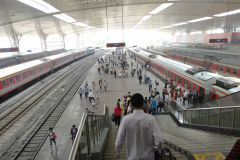Nanjing, also known as Nanking, is a city with a rich and complex history. Located in eastern China, it has been an important cultural, economic, and political center for centuries.
The earliest known settlement in the area of Nanjing dates back to the Neolithic period, around 5000 BCE. The city was known as Jinling during the ancient period and served as the capital of various kingdoms and dynasties throughout Chinese history.
During the Eastern Han Dynasty (25-220 CE), Nanjing became an important economic and cultural center, known for its production of ceramics, textiles, and metalwork. The city continued to prosper during the Three Kingdoms period (220-280 CE) and the Sixteen Kingdoms period (304-439 CE).
In the 5th century, Nanjing became the capital of the Wu Kingdom during the Southern and Northern Dynasties period. The Wu Kingdom was known for its strong navy and its role in spreading Buddhism in China.
In the 14th century, under the Ming Dynasty, Nanjing became the capital of China and remained so for several decades. The city was expanded and fortified, with the construction of the city walls, gates, and the famous Porcelain Tower.
During the 19th century, Nanjing was occupied by foreign powers, first by the British during the First Opium War (1839-1842), and then by the Taiping rebels during the Taiping Rebellion (1850-1864). In 1937, the city was invaded by the Japanese during the Second Sino-Japanese War and was the site of the infamous Nanjing Massacre, in which an estimated 300,000 Chinese civilians and soldiers were killed.
After the war, Nanjing was rebuilt and re-established as the capital of Jiangsu province. Today, the city is a major economic and cultural center, known for its museums, universities, and historical sites, such as the Nanjing Yangtze River Bridge and the Memorial Hall for the Victims of the Nanjing Massacre.







